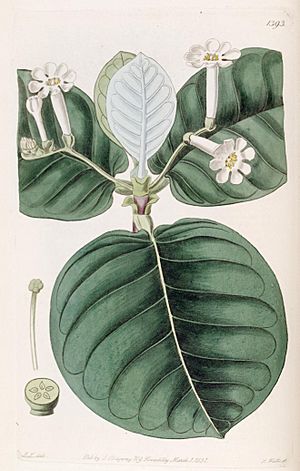Guettarda speciosa facts for kids
Quick facts for kids Guettarda speciosa |
|
|---|---|
 |
|
 |
|
| Guettarda speciosa (artist John Lindley) | |
| Scientific classification | |
| Kingdom: | |
| (unranked): | |
| (unranked): | |
| (unranked): | |
| Order: | |
| Family: | |
| Genus: |
Guettarda
|
| Species: |
G. speciosa
|
| Binomial name | |
| Guettarda speciosa |
|
 |
|
| Occurrence data from GBIF | |
Guettarda speciosa, also known as sea randa or zebra wood, is a type of shrub. It belongs to the Rubiaceae plant family. You can find this plant growing in tropical coastal areas around the Pacific Ocean. This includes places like central and northern Queensland and the Northern Territory in Australia. It also grows on Pacific Islands such as Micronesia, French Polynesia, and Fiji. Other locations include Malaysia, Indonesia, the Maldives, and the east coast of Africa.
This plant can grow up to 6 meters (about 20 feet) tall. It has beautiful, sweet-smelling white flowers. Its large green leaves have veins that stand out. It typically grows in sand, just above where the high tide reaches.
Contents
Plant Names and History
Different cultures have their own names for Guettarda speciosa. For example, in the Cook Islands, people call it Ano, Hano, Fano, or Puapua. In Samoa, it's also called Puapua. The people of Tonga use a similar name, Puopua. In the Marshall Islands, it is known as utilomar.
The famous scientist Carl Linnaeus first described and named this plant. The genus name, Guettarda, honors an 18th-century French naturalist named Jean-Étienne Guettard. The second part of its scientific name, speciosa, comes from a Latin word. It means 'showy', which fits because of its attractive flowers.
What the Plant Looks Like
The sea randa is a perennial shrub or a small tree. It usually grows between 2 and 6 meters (6.5 to 20 feet) tall. It can spread out about 1 to 3 meters (3 to 10 feet) wide. Its bark is smooth and has a creamy grey color.
The leaves are large and oval-shaped. They are about 15 to 23 centimeters (6 to 9 inches) long and 10 to 18 centimeters (4 to 7 inches) wide. The top side of the leaves is dark green and smooth. You can see lighter veins clearly on them. The underside of the leaves feels finely hairy.
This plant blooms from October to May. Its white flowers are very fragrant. Each flower is about 2.5 to 3 centimeters (1 to 1.2 inches) long. They have 4 to 9 small petal-like parts called lobes. After the flowers, the plant produces hard, round fruits. These fruits also smell sweet. They measure about 2.5 to 2.8 centimeters (1 to 1.1 inches) long and 2.2 to 2.5 centimeters (0.9 to 1 inch) wide. The fruits ripen between September and March.
Where the Plant Grows
Guettarda speciosa is found in tropical coastal areas. It grows around the Pacific Ocean. You can see it along the coastlines of central and northern Queensland and the Northern Territory in Australia. It also thrives on many Pacific Islands. These include Micronesia, French Polynesia, and Fiji. Other places where it grows are Malaysia, Indonesia, the Maldives, and the east coast of Africa. As its common name, beach gardenia, suggests, it prefers beaches and sandy spots. It grows just above the high tide line.
Ecology and Wildlife
The Mariana fruit bat (Pteropus mariannus) enjoys eating the fruit and flowers of the sea randa. When these bats eat the fruit, they help spread the plant's seeds. This helps new sea randa plants grow in different places.
How People Use This Plant
Traditional Uses
Indigenous people in northern Australia used the large leaves of the sea randa in many ways. They would use the leaves to hold food. When the leaves were warmed up, they could be placed on the body to help with headaches and sore limbs. The stems of the plant were also used to make pipes.
On the Cook Islands, people used the fragrant flowers to add scent to coconut oil. The wood from the plant was also used to build homes and canoes.
Growing the Plant
The sea randa is a very useful plant for planting near the sea in tropical areas. It needs a sunny spot to grow well. It also requires soil that drains water easily. It can be a bit tricky to grow new plants from seeds. The seeds can take several months to sprout.

